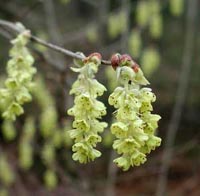Resource Library
Plant of the Week: Winterhazel
The University of Arkansas System Division of Agriculture does not promote, support or recommend plants featured in "Plant of the Week." Please consult your local Extension office for plants suitable for your region.
Plant of the Week
Winterhazel
Latin: Corylopsis platypetala

Springtime arrives reluctantly in my shade garden, always a week or two behind the sunny spots that experience the warmth of the afternoon sun. But even in my cool and shaded garden, one plant provides an early warning for spring’s arrival. This shrub, Corylopsis platypetala, (Winterhazel), has become a favorite as it has grown, providing a shower of light yellow blooms against the late winter bleakness of the woodlands.
Several winterhazels are grown, primarily differentiated by ultimate size, the shape of the hazel-like leaves and the number of blooms on the drooping panicles. Mine is a deciduous shrub growing 10 to 12 feet tall and wide with a confusing array of branches arising from the base. It belongs to the witchhazel family and has the branching habit and bushiness of that tribe.
Winterhazel is a good name for it tells us of the plants’ relationship with the hazelnuts - their leaves are similar in appearance - and advises us it is early-to-flower. Blooms are produced along the branches in a cascade of 2- to 3-inch long panicles, each crowded with eight to 12 light yellow flowers individually about the size of a dime. Plants in bloom look like they are draped with dangling ear bobs suited for a Spanish flamingo dancer. The panicles are produced in sufficient quantity to create an effective display even when viewed from a distance.
By early March every branch is pregnant with possibility as flower buds swell up and down its length. In north Arkansas blooms usually appear between the 10th and 20th of March, putting it in the same season as forsythia. But forsythia won’t do in my woodland garden - I’ve tried.
This winterhazel was collected by the famous plant hunter, China Wilson in 1907 when he tromped through Hupeh Province in southwestern China. It and the other species grow at the edge of the woods in their native home, hinting at their cultivation in the garden. It will grow in sunny sites, and may make more blooms in the sun.
It is not commonly offered in the retail garden trade, so you may have to do some searching amongst the offerings of nursery growers who like to specialize in unusual plants. It is available from a number of mail-order nurseries that sell over the web.
Winterhazel has little special merit when not in bloom. It is a neat and tidy shrub with three to four inch long, medium textured leaves. It seems unbothered by insects or disease. It produces no significant fall color.
But, it is easy to be a standout, especially when there is little or no competition. Because winterhazel blooms so early, its impact on the spirit and character of the garden is more pronounced than if it flowered during the height of springtime bloom a month later. This gives them special currency in my mind, making them the ideal additions to any woodland planting.
By: Gerald Klingaman, retired
Extension Horticulturist - Ornamentals
Extension News - April 22, 2005
The University of Arkansas System Division of Agriculture does not maintain lists of retail outlets where these plants can be purchased. Please check your local nursery or other retail outlets to ask about the availability of these plants for your growing area.